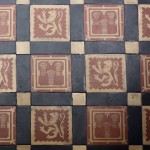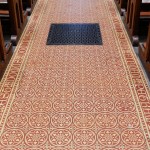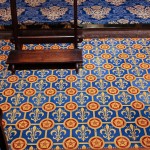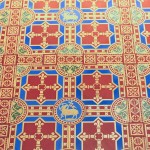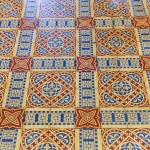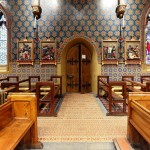 On Chapel Street, wedged into the tightly-knit back alleys of Cheadle, is A. W. N. Pugin’s awesome St Giles R. C. Church, a revelatory vision of colour, decoration and delight. For Pugin, who was received into the Catholic Church in 1835, the structure of a church was religion in built form, and the intent behind St Giles was to produce a modern version of a fourteenth-century country parish church.[1] The true church – pre-reformation Catholicism – would thus be housed in its true home, a Gothic church. His patron was John Talbot, sixteenth Earl of Shrewsbury and the leading Catholic layman of the time, whose seat lay a few miles to the east at Alton Towers; Pugin began work there on a banqueting hall and chapel in 1837. The church itself was built in 1841-6, part of the multitudinous decorations on its soaring steeple being twin Talbot hounds; below it are the striking west doors, each bearing the family symbol, a golden lion within a scalloped border on bright red ground.
On Chapel Street, wedged into the tightly-knit back alleys of Cheadle, is A. W. N. Pugin’s awesome St Giles R. C. Church, a revelatory vision of colour, decoration and delight. For Pugin, who was received into the Catholic Church in 1835, the structure of a church was religion in built form, and the intent behind St Giles was to produce a modern version of a fourteenth-century country parish church.[1] The true church – pre-reformation Catholicism – would thus be housed in its true home, a Gothic church. His patron was John Talbot, sixteenth Earl of Shrewsbury and the leading Catholic layman of the time, whose seat lay a few miles to the east at Alton Towers; Pugin began work there on a banqueting hall and chapel in 1837. The church itself was built in 1841-6, part of the multitudinous decorations on its soaring steeple being twin Talbot hounds; below it are the striking west doors, each bearing the family symbol, a golden lion within a scalloped border on bright red ground.
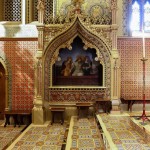 Inside the church, all is colour, ornament and pattern, from the encaustic tiles, which cover the entire floor area as well as the nave dados, to the gilded and painted roof. Work began on the interior decoration in 1844, and Pugin himself was responsible for the design of many of the church furnishings, including the majority of the tiles, which were manufactured by Minton’s. The tile pavement, ornate even at the west end where it includes several inscriptions, increases in complexity and lavishness to culminate in the Chapel of the Blessed Sacrament with its golden reredos of printed and painted tiles. The nave, porch and west tower floor tiles are all two-coloured encaustics (buff and red or buff and black) while those further east are multi-coloured; these latter are undoubtedly by Pugin. The tile designs used in the main body of the church appear in Minton’s first printed catalogue of 1842, thus it might be argued that no direct connection exists between Pugin and these tiles. However, it appears likely that at least some of the nave designs were by Pugin’s hand, including the Talbot symbol tile, number five in the 1842 catalogue[2]
Inside the church, all is colour, ornament and pattern, from the encaustic tiles, which cover the entire floor area as well as the nave dados, to the gilded and painted roof. Work began on the interior decoration in 1844, and Pugin himself was responsible for the design of many of the church furnishings, including the majority of the tiles, which were manufactured by Minton’s. The tile pavement, ornate even at the west end where it includes several inscriptions, increases in complexity and lavishness to culminate in the Chapel of the Blessed Sacrament with its golden reredos of printed and painted tiles. The nave, porch and west tower floor tiles are all two-coloured encaustics (buff and red or buff and black) while those further east are multi-coloured; these latter are undoubtedly by Pugin. The tile designs used in the main body of the church appear in Minton’s first printed catalogue of 1842, thus it might be argued that no direct connection exists between Pugin and these tiles. However, it appears likely that at least some of the nave designs were by Pugin’s hand, including the Talbot symbol tile, number five in the 1842 catalogue[2]
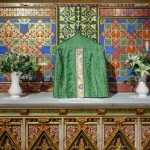
In sum, St Giles is a very English church; it was built by local men using local materials, all in the service of the only true church. With all its colour and richness, it was too English for the mid nineteenth-century Roman tradition of Catholicism; ironically, its influence – in architectural terms – weighed most heavily on the Church of England. As to its tiles, which saw Pugin’s designs progress from the use of medieval motifs to a more individualistic and colourful approach, one can only echo the words of the future Cardinal Newman, overwhelmed by the sumptuous Chapel of the Blessed Sacrament at St Giles: ‘This is the gate of heaven’.[3]
Web Site: http://www.stgilescatholicchurch.co.uk/
Footnotes:
1. Paul Atterbury and Clive Wainwright, Pugin: A Gothic Passion (Yale University Press, New Haven and London, 1994), p68.
2. Carol Maund and Hans van Lemmen, Encaustic Tiles in St Giles, Cheadle, Staffordshire (Tiles and Architectural Ceramics Society, 1984).
3. Michael Fisher, A Vision of Splendour: Gothic Revival in Staffordshire, 1840-1890 (Fisher, Stafford, 1995), pp94-101.

